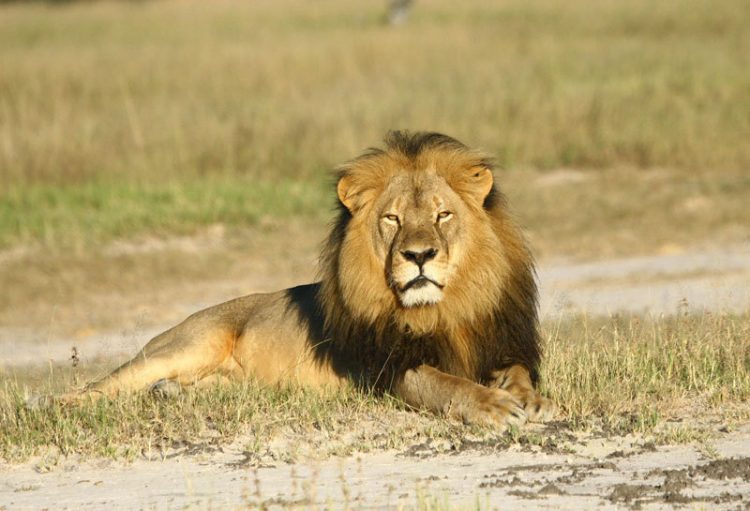GPS transmitters can protect animals from poaching

Cecil the Lion, in Hwange Nationalpark, Zimbabwe. © WildCRU/Andrew Loveridge
The killing of the lion Cecil in a national park in Zimbabwe by a big-game hunter has sparked worldwide outrage. Researchers at the University of Oxford had outfitted Cecil with a GPS collar to monitor his behaviour. It was only thanks to this special tag that the cause of the animal's death was cleared up. At the Max Planck Institute for Ornithology in Radolfzell, scientists also use transmitters to observe the behavior of different species of animals.
The data collected through telemetry is so accurate that it can help to quickly locate killed animals and clear up their cause of death. From 2016, the satellite-based system Icarus will also capture the global movement patterns of animals. Icarus will thus significantly improve the protection of endangered species.
The American big-game hunter's first attempt to kill the lion with a crossbow failed. Only after chasing the animal, and with the support of local trackers, he was finally able to kill the animal. According to the hobby hunter, he did not suspect that this was not just an “ordinary” animal. The movements of the big cat were monitored as part of a research project at the University of Oxford in the UK aimed at protecting wildlife populations. This is why Cecil wore a GPS collar that tracked and reported his locations, and the date of which ultimately led wildlife rangers to the hunter.
Scientists at the Max Planck Institute for Ornithology also study the behavior of animals with transmitters, which teach them a lot about the migratory movements and habitats of endangered species. But they also record the death of an animal. Dina Dechmann, for example, monitors the routes of pigeons. With the help of transmitters, she can determine where and when these birds fall victim to birds of prey.
“In the case of danger, risk-averse individuals first leave the swarm in order to escape. This makes them an easy target. In one case, we could tell through transmitters which we later found close to a falcon's nest that the birds were killed by a bird of prey and not shot by a hunter,” reports Dechmann.
The same applies to studies of the bald ibis. Conservationists want to reintroduce this migratory bird, who was once native to Europe, to Austrian and Italian forests. Similar as in Cecil's case, scientists were able, through data loggers, to identify a hunter who had illegally shot such a bird.
In this way, scientists can also establish where and which migratory birds, such as songbirds or storks, are killed on their yearly travels. This is essential information for species protection. “The signals from the transmitters are so precise that we could even register where a shot mallard fell to Earth. So far, however, this is only a by-product of our research, “says Dechmann.
The position data is primarily used to investigate the behavior of the animals and their movement patterns. So far, researchers have been mainly interested in the causes of death in order to understand population fluctuations. “However, the data loggers may also be specifically used to reduce the hunting of endangered animals,” said Dechmann.
Soon, scientists at the Max Planck Institute for Ornithology will have even more opportunities to track animals – through a satellite system. From 2016 onwards, under the guidance of Martin Wikelski, director at the Max Planck Institute in Radolfzell, the international consortium Icarus (International Cooperation for Animal Research Using Space) will globally monitor the movements of many animals at the same time. Solar powered GPS mini transmitters will be sending their data to the International Space Station and from there to research groups worldwide.
Icarus will not only deter potential poachers with its transmitters but, but also contribute to the protection of wildlife animals in other ways, with a lot of data being freely accessible. And the AnimalTracker app will enable everyone to participate in the project, upload their own wildlife observations and make them available to researchers.
“Thanks to Icarus, we can follow the lives of animals almost from the sofa. It strengthens our connection with them and thus hopefully also our appreciation of our fellow creatures,” says Wikelski. While all of this is too late for Cecil, there is still hope for many other endangered animals. “With the data gained through Icarus, people can forge a personal relationship with wild animals similar to Cecil. I am sure that this global attention will protect many animals from illegal hunting, “said Wikelski.
Contact
Dr. Dina Dechmann
Max Planck Institute for Ornithology (Radolfzell), Radolfzell
Phone: +49 7732 150-173
Email: ddechmann@orn.mpg.de
Media Contact
All latest news from the category: Ecology, The Environment and Conservation
This complex theme deals primarily with interactions between organisms and the environmental factors that impact them, but to a greater extent between individual inanimate environmental factors.
innovations-report offers informative reports and articles on topics such as climate protection, landscape conservation, ecological systems, wildlife and nature parks and ecosystem efficiency and balance.
Newest articles

Compact LCOS Microdisplay with Fast CMOS Backplane
…for High-Speed Light Modulation. Researchers from the Fraunhofer Institute for Photonic Microsystems IPMS, in collaboration with HOLOEYE Photonics AG, have developed a compact LCOS microdisplay with high refresh rates that…

New perspectives for material detection
CRC MARIE enters third funding period: A major success for terahertz research: Scientists at the University of Duisburg-Essen and the Ruhr University Bochum have been researching mobile material detection since…

CD Laboratory at TU Graz Researches New Semiconductor Materials
Using energy- and resource-saving methods, a research team at the Institute of Inorganic Chemistry at TU Graz aims to produce high-quality doped silicon layers for the electronics and solar industries….



